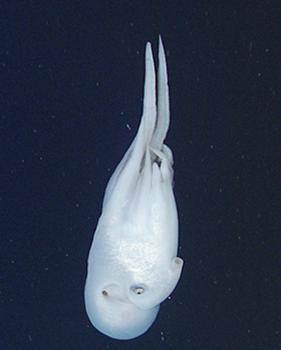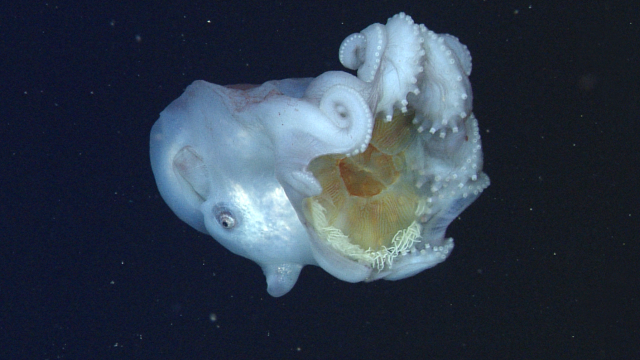The giant deep-sea octopus Haliphron is so rare that marine biologists have seen it just three times in 27 years. Using a robotic sub, scientists have finally caught video footage of this animal at mealtime — revealing its distinct preference for gelatinous sea creatures.
A female Haliphron holding an egg-yolk jellyfish in her arms. (Image: MBARI)
A new study published in Scientific Reports is providing the first observational evidence of Haliphron atlanticus, a normally camera-shy giant deep-sea octopus, feasting on gelatinous prey. Previously, scientists had argued that jellies lack nutritional value, but these latest findings are forcing a reevaluation.
Despite its size, very little is known about this deep-sea octopus. It’s rarely seen in the wild, so much of our knowledge has been gleaned from specimens found in fishing nets. Prior to the new study, marine biologists weren’t even sure what it ate.
This animal is sometimes referred to as the “seven-arm octopus” because of the way the male tucks one of its eight arms into a sac underneath its eye. The males are diminutive, just 30cm long, but the females are giants, measuring 4m in length and weighing as much as 75kg. It’s one of the more extreme cases of sexual dimorphism in a species.
Using a remotely-operated vehicle (ROV), marine biologists Henk-Jan Hoving of GEOMAR Helmholtz Centre for Ocean Research Kiel and Steve Haddock of the Monterey Bay Aquarium Research Institute (MBARI) observed Haliphron in action. On a recent expedition to the Monterey Submarine Canyon off the California coast, their robotic sub spotted the octopus with a large jellyfish cradled in its clutches.

Taking advantage of its large size, Haliphron had managed to grasp and hold the entire jelly, estimated to be about 30cm in width, within its webbed arms. It then used its beak to bite through the “bell” of the jelly, gaining access to the digestive cavity and the food inside, and to reach the more nutritious parts. By this stage of the meal, the jellyfish was dead, but its bell and its outer fringe remained intact. Incredibly, Haliphron continued to hold on to these body parts after it had finished its meal. The scientists suspect this was for defensive purposes or to capture more prey; the jellyfish’s stinging tentacles are still active even after it’s dead.
This field observation inspired the researchers to revisit archived footage of Haliphron. When they did so, they noticed at least one Haliphron specimen holding onto what appeared to be a gelatinous sea creature. To corroborate these observations, the researchers analysed the stomach contents of five specimens caught in trawling nets. All of the bellies contained traces of gelatinous zooplankton. In addition, three of the five octopuses had stomachs full of jellyfish, one contained a siphonophore (jellyfish-like floaters), and one a salp (a snake-like gelatinous blob).
Haddock and his colleagues believe that gelatinous sea creatures are an unappreciated food source for marine animals — this despite the fact that other animals, such as ocean sunfish, leatherback sea turtles, tuna and other large fish, also eat jellies. It’s generally thought that these organisms lack nutrients, but given that the animals who feast upon them tend to be large, this idea doesn’t, ahem, hold water. In the new study, the biologists argue that the weight of a jelly translates to significant biomass, and therefore kilojoules.
Haliphron, like so many other creatures in the ocean, follows a very simple, but effective, strategy: Move and eat slowly — but grow large.
